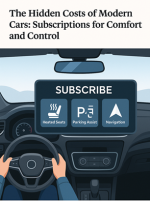The Hidden Costs of Modern Cars: Subscriptions for Comfort and Control
Introduction
The automotive world is quietly shifting toward a new and controversial trend: subscriptions for built-in car features.
Manufacturers like BMW, Volvo, and Mercedes-Benz are experimenting with the “software-as-a-service” model — the same concept that drives Netflix or Spotify.
But when it comes to cars, paying monthly for something like heated seats, adaptive cruise control, or navigation feels different.
After all, the hardware is already in the vehicle — you just need to pay to “turn it on.”
The Software-as-a-Service Model in Cars
In traditional cars, once you paid for a feature, you owned it.
In modern EVs, automakers are embedding dozens of features into vehicles but locking them behind digital paywalls. Owners can then unlock them temporarily via monthly fees.
For example:
- BMW Germany once tested a €18/month subscription for heated seats.
- Mercedes offered faster acceleration as part of a $1,200 yearly “Performance Boost.”
- Volvo and Polestar have experimented with subscription-based driver assistance and connectivity packages.
The reasoning? Carmakers see software as an ongoing revenue source — a way to generate profit long after the sale.

Why Drivers Are Upset
Car buyers aren’t happy.
They feel like they’re paying twice — once for the car and again for features that are physically installed but intentionally disabled.
On EV and car forums across the U.S., Canada, and Europe, common reactions include:
- “If the heated seats are already in the car, why am I renting them?”
- “I just want to pay once and own the function forever.”
- “It feels like we’re leasing software for things we already bought.”
Beyond frustration, there’s also confusion. Most drivers don’t know if subscriptions are optional, temporary, or region-specific. Some owners discover features they didn’t even realize they had — until they’re prompted to “subscribe.”
Automakers’ Perspective
From the manufacturers’ viewpoint, these fees aren’t about greed — they’re about adapting to an electric future.
Electric cars rely more on software than mechanics, and software can be updated, improved, and monetized.
They argue that:
- Subscriptions can lower upfront costs for buyers who only want certain features.
- Software updates ensure constant improvements and bug fixes.
- Optional monthly features keep vehicles customizable over time.
Still, the backlash has shown that customers view cars differently from apps — they expect ownership, not ongoing fees.
Legal and Ethical Questions
In some European countries, regulators are now investigating whether such “feature locks” violate consumer protection laws.
The argument: if the hardware is physically installed and fully functional, it might be misleading to charge extra for using it.
Consumer-rights groups in Germany and the UK are already pushing for clearer transparency on what’s included in the sale versus what’s subscription-only.
What EV Owners Can Do
If your new car comes with optional digital subscriptions, you have choices:
- Check for one-time unlocks. Some brands quietly offer permanent activation for a fixed price.
- Contact your dealer. Ask which features are hardware-locked and which are truly software-only.
- Read the fine print. Some trial subscriptions renew automatically after free periods.
- Look for third-party apps or OBD tools — in some cases, independent garages can legally activate paid features (though this may void warranty).
- Provide feedback. Many automakers have scaled back these programs after consumer pushback.
The Future of Car Ownership
As EVs evolve, so will the way we pay for them. The car industry’s dream is “mobility as a service” — flexible, upgradeable, and continuously monetized.
But the question remains: should convenience come with a monthly fee for something you already own?
